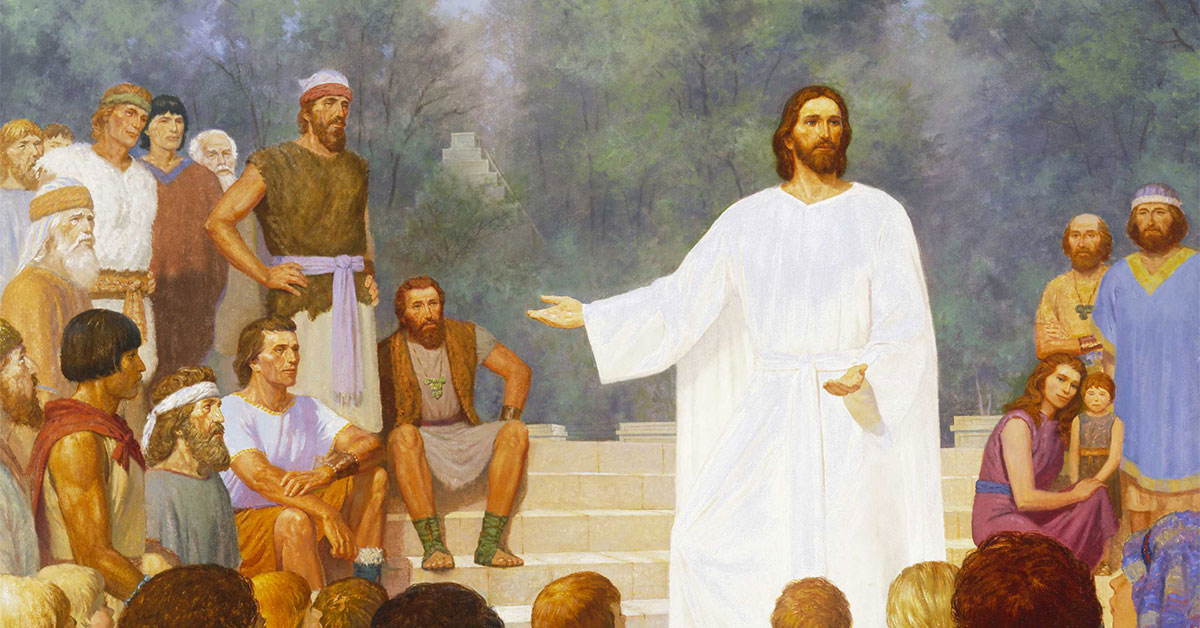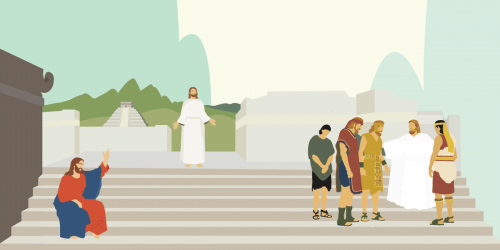You are here
Book of Mormon Central is in the process of migrating to our new Scripture Central website.
We ask for your patience during this transition. Over the coming weeks, all pages of bookofmormoncentral.org will be redirected to their corresponding page on scripturecentral.org, resulting in minimal disruption.
Come Follow Me 2020: 3 Nephi 12-16

Scripture Block
3 Nephi 12-16
September 21–27. “I Am the Law, and the Light”
Recommended Resources
Learn about the Book of Mormon with verse by verse commentaries from renowned Book of Mormon scholars like John W. Welch and Brant A. Gardner in the ScripturePlus app. Read this week's KnoWhy connected with the Come Follow Me curriculum, and watch a video elucidating an insight in this week's scripture reading.
KnoWhys
Reading Plan
Structure your personal scripture study by following a multimedia, day by day plan. Each day's assignment includes the required scripture passages from the Come Follow Me curriculum, as well as suggestions for additional resources to bring context and understanding to your study.
Monday
- Scripture: 3 Nephi 12:1-20
-
Quote: “This sermon is a recapitulation, a summary, and a digest of what men must do to gain salvation; and the eternal concepts in it are so stated that hearers (and readers) will get out of it as much as their personal spiritual capacity permits. To some it will point the way to further investigation; to others it will confirm and reconfirm eternal truths already learned from the scriptures and from the preachers of righteousness of their day; and to those few whose souls burn with the fires of testimony, devotion, and valiance, it will be as the rending of the heavens: light and knowledge beyond carnal comprehension will flow into their souls in quantities that cannot be measured. Every man must judge and determine for himself the effect [this sermon] will have upon him.”
McConkie, Bruce R. The Mortal Messiah. Salt Lake City, UT: Deseret Book, 1980. 2:116. - KnoWhy 203: Why Did Jesus Deliver a Version of the Sermon on the Mount at the Temple in Bountiful?
-
Quote: “The Savior’s coming to the Nephites out of darkness and great destruction was to them a miracle of light. A ‘Man’ descended out of heaven dressed in a white robe, and he declared, ‘I am the light and the life of the world.’ In a series of unforgettable instructions, the Savior taught those who stood before him at Bountiful to be ‘the light of this people,’ to realize that ‘the light of the body is the eye,’ and that ‘I am the law, and the light.’ They were also to hold up their light ‘that it may shine unto the world.’”
Rust, Richard Dilworth. “Book of Mormon Imagery.” In Rediscovering the Book of Mormon, 135. Salt Lake City, UT: Deseret Book Co., 1991.
Explore Further
Tuesday
- Scripture: 3 Nephi 12:21-48
-
Quote: “In a well-known passage in the Sermon on the Mount, the King James translation of Matthew 5:22 reads, ‘Whosoever is angry with his brother without a cause [eikei] shall be in danger of the judgment’ (emphasis added). Yet the phrase without a cause is absent in most of the best and earliest Greek manuscripts of the New Testament. Joseph Smith could hardly have guessed that this phrase did not originally belong in this passage, because textual criticism of the Bible was scarcely in its infancy in America in 1829. And yet, significantly, the parallel text in the Sermon at the Temple in the Book of Mormon agrees with those early manuscripts, precisely lacking the phrase without a cause.”
Welch, John W. “A Steady Stream Of Significant Recognitions.” Essay. In Echoes and Evidences of the Book of Mormon, edited by Donald W. Parry, Daniel C. Peterson, and John W. Welch, 333–334. Provo, UT: Foundation for Ancient Research and Mormon Studies, 2002. - KnoWhy 335: What Does It Mean to Be Perfect?
Wednesday
- Scripture: 3 Nephi 13:1-34
-
Quote: “The problem is in the vainness, not in repetition. In how many different ways can we bless our food? How many original prayers—original in the sense of novel or unusual language—can we offer? God is not offended by repetition, so long as the words are spoken from the heart and are sincere. The heavens withdraw themselves, however, in the face of vanity. Something is vain when it is empty, meaningless, or hollow. Whenever our prayers are meaningless and thus become trite or ritualistic religious jargon, having no feeling or emanating from a duplicitous heart, they accomplish little.”
McConkie, Joseph Fielding, and Robert L. Millet. Doctrinal Commentary on the Book of Mormon. Vol. 4. Salt Lake City, UT: Deseret Book, 2002. 81. - KnoWhy 204: Why Is the Lord's Prayer Different in 3 Nephi?
-
Quote: “Don’t worry about tomorrow, because you may have no tomorrows. … And if you can always witness honestly that whatever you did, you did to the best of your ability, and next day try improvement on that, when your life’s end comes, of you it can be said in truth, his was a successful life because he lived to the best that was in him. That’s all the Lord expects of any one of His children. We are all born with different capacities, some to do one thing, some to do the other, and all He asks is that we do our best; and that’s the measure by which we’ll be judged when that time comes.”
Lee, Harold B. The Teachings of Harold B. Lee. Edited by Clyde J. Williams. Salt Lake City, UT: The Church of Jesus Christ of Latter-day Saints, 2015. 64-65
Thursday
- Scripture: 3 Nephi 14:1-14
-
Quote: “The Savior admonished, ‘Have peace one with another.’ Peace must first come from within. It flows from the individual to the home, to the community, to the nations, and to the world. This peace can only come as we resist the damaging pastime of passing judgment. In the scriptures we are warned to judge not, that we be not judged. Somehow there seems to be something enticing and intriguing about being a self-appointed judge.”
Ashton, Marvin J. "Straightway," General Conference April 1983 -
Quote: “A testimony is personal knowledge of spiritual truth obtained by revelation. A testimony is a gift from God and is available to all of His children. Any honest seeker of truth can obtain a testimony by exercising the necessary ‘particle of faith’ in Jesus Christ to ‘experiment upon’ and ‘try the virtue of the word’ to yield ‘to the enticings of the Holy Spirit’ and to awaken unto God. Testimony brings increased personal accountability and is a source of purpose, assurance, and joy. Seeking for and obtaining a testimony of spiritual truth requires asking, seeking, and knocking with a sincere heart, real intent, and faith in the Savior. Fundamental components of a testimony are knowing that Heavenly Father lives and loves us, that Jesus Christ is our Savior, and that the fulness of the gospel has been restored to the earth in these latter days.”
Bednar, David A. “Converted unto the Lord,” General Conference October 2012 - KnoWhy 206: What Makes 3 Nephi the Holy of Holies of the Book of Mormon?
Friday
- Scripture: 3 Nephi 14:15-27
- KnoWhy 527: Why Must We Beware Wolves in Sheep’s Clothing?
- KnoWhy 205: Why Did Jesus Say that Some Well-Intentioned People Will Be Told to Depart?
Saturday
- Scripture: 3 Nephi 15:1-24
-
Quote: “[T]he stated purpose of the Sermon at the Temple is to show the disciple how to be exalted at the final judgment. Jesus said, ‘Whoso remembereth these sayings of mine and doeth them, him will I raise up at the last day.’ The Sermon contains, therefore, not just broad moral platitudes, but a concise presentation of conditions that must be satisfied in order to be admitted into God’s presence. Looking at the Sermon at the Temple in a covenant-making context dramatically enhances its meaning. For example, the prerequisite that no person should come unto Christ having any ill feelings toward a brother then has new meaning. The instruction that people should swear their oaths simply by saying ‘yes’ or ‘no’ makes eminent sense as covenantal promises are being made. The reciting of a group prayer (‘when ye pray’ in 13:7-9) appears to call for a collective petition to the Lord. And the obligation of secrecy, that one ‘give not that which is holy unto the dogs,’ with its accompanying threat that violators will be trampled and torn, fits a covenant-making context exactly, even though it has been one of the most puzzling parts of the Sermon on the Mount for many scholars.”
John W. Welch, “The Sermon at the Temple,” in Reexploring the Book of Mormon, Edited by John W. Welch. Salt Lake City, Utah: Deseret Book, 1992, 254. -
Quote: [I]t is crucial to understand that the law of Moses was overlaid upon, and thereby included, many basic parts of the gospel of Jesus Christ, which had existed before it. It was never intended to be something apart or separated from, and certainly not something antagonistic to, the gospel of Jesus Christ. It was more elementary than the full gospel—thus its schoolmaster’s role in bringing people to the gospel—but its purpose was never to have been different from the higher law. Both were to bring people to Christ.”
Holland, Jeffrey R. Christ and the New Covenant. Salt Lake City, UT: Deseret Book, 1997, 147. - KnoWhy 207: Why Did Jesus Say That There Were “Other Sheep” Who Would Hear His Voice?
Sunday
- Scripture: 3 Nephi 16:1-20
-
Quote: “Earlier in the Book of Mormon, the Lord promises that in the mouths of three great scriptural witnesses the divinity of Christ would be established. It is of interest to note that evidently the resurrected Jesus Christ appeared to all of the peoples who were to write these great scriptural witnesses. He appeared as a resurrected being to the Jews, from whom we get the Bible; he appeared as a resurrected being to the Nephites, from whom we get the Book of Mormon; and he promises here that he is going to appear as a resurrected being to the lost tribes of Israel, from whom shall come the third great scriptural witness.”
Ludlow, Daniel H. A Companion to Your Study of the Book of Mormon. Salt Lake City: Deseret Book, 1976, 271. - KnoWhy 208: Why is the Sermon at the Temple Echoed throughout the Rest of 3 Nephi?
Additional Resources (Bibliography)
3 Nephi 12
Brown, S. Kent. “Moses and Jesus: The Old Adorns the New.” In The Book of Mormon: 3 Nephi 9-30, This is My Gospel, edited by Monte S. Nyman and Charles D. Tate, Jr., 89–100. Provo, UT: Religious Studies Center, Brigham Young University, 1993.
Christ in America Timeline. Springville, UT: Book of Mormon Central, 2016.
What Would Jesus Do? (3 Nephi 11-28). Springville, UT: Book of Mormon Central, 2016.
Sperry, Sidney B. “The Book of Mormon and the Problem of the Sermon on the Mount.” Journal of Book of Mormon Studies 4, no. 1 (1995): 153–165.
Sweat, Anthony. “Active Learning and the Savior's Nephite Ministry.” Religious Educator 10, no. 3 (2009): 75–86.
Welch, John W. Illuminating the Sermon at the Temple & the Sermon on the Mount. Provo, UT: FARMS, 1999.
Welch, John W. “The Sermon at the Temple and the Sermon on the Mount: The Differences.” In Illuminating the Sermon at the Temple & the Sermon on the Mount, 125–150. Provo, UT: FARMS, 1999.
Welch, John W. “Worthy of Another Look: Reusages of the Words of Christ.” Journal of the Book of Mormon and Other Restoration Scripture 22, no. 1 (2013): 62–72.
3 Nephi 12:1
Welch, John W., and Greg Welch. “Who Kept the Records in the Book of Mormon? (By Lineages).” In Charting the Book of Mormon: Visual Aids for Personal Study and Teaching. Provo, UT: Foundation for Ancient Research and Mormon Studies, 1999, chart 17.
3 Nephi 12:6
Book of Mormon Central. “Why Did Jesus Deliver a Version of the Sermon on the Mount at the Temple in Bountiful? (3 Nephi 12:6).” KnoWhy 203 (October 6, 2016).
Tvedtnes, John A. “Hungering and Thirsting after Righteousness.” In The Most Correct Book: Insights from a Book of Mormon Scholar, 282–284. Salt Lake City: Cornerstone Publishing, 1999.
3 Nephi 12:13
Baker, LeGrand L. “What does it mean to be the ‘salt of the earth’?” Ensign 29, no. 4 (1999).
3 Nephi 12:22
Judd, Daniel K. “A Scriptural Comparison Concerning Anger: 3 Nephi 12:22 and Matthew 5:22.” In The Book of Mormon and the Message of The Four Gospels, edited by Ray L. Huntington and Terry B. Ball, 57–76. Provo, UT: Religious Studies Center, 2001.
3 Nephi 12:25–26
Smith, Joseph F. “Questions and Answers - Meaning of Prison in III Nephi.” Improvement Era 8, no. 3 (1905): 226.
3 Nephi 12:32
Chamberlain, Jonathan M. “I Have a Question: What is the meaning of Luke 16:18 and 3 Nephi 12:32?” Ensign 23, no. 1 (1993): 59–60.
3 Nephi 12:48
Book of Mormon Central. “What Does It Mean to Be Perfect? (3 Nephi 12:48).” KnoWhy 335 (July 5, 2017).
What Does It Mean to Be Perfect? (3 Nephi 12:48). Springville, UT: Book of Mormon Central, 2017.
3 Nephi 13
Christ in America Timeline. Springville, UT: Book of Mormon Central, 2016.
What Would Jesus Do? (3 Nephi 11-28). Springville, UT: Book of Mormon Central, 2016.
Sweat, Anthony. “Active Learning and the Savior's Nephite Ministry.” Religious Educator 10, no. 3 (2009): 75–86.
Welch, John W. Illuminating the Sermon at the Temple & the Sermon on the Mount. Provo, UT: FARMS, 1999.
3 Nephi 13:9–13
Bergin, Sue. “Lord's Prayer.” In Encyclopedia of Mormonism, Edited by Daniel H. Ludlow. Vol. 2. New York: Macmillan, 1992.
Book of Mormon Central. “Why Is the Lord's Prayer Different in 3 Nephi? (3 Nephi 13:9).” KnoWhy 204 (October 7, 2016).
Parry, Donald W. “After This Manner…Pray Ye.” Ensign January 1996.
Welch, John W. “Two Notes on the Lord’s Prayer.” In Pressing Forward with the Book of Mormon: The FARMS Updates of the 1990s, edited by John W. Welch and Melvin J. Thorne, 228–230. Provo, UT: FARMS, 1999.
Why is the Lord's Prayer Different in 3 Nephi? Springville, UT: Book of Mormon Central, 2016.
3 Nephi 14
Christ in America Timeline. Springville, UT: Book of Mormon Central, 2016.
What Would Jesus Do? (3 Nephi 11-28). Springville, UT: Book of Mormon Central, 2016.
Welch, John W. Illuminating the Sermon at the Temple & the Sermon on the Mount. Provo, UT: FARMS, 1999.
3 Nephi 14:13–14
Book of Mormon Central. “What Makes 3 Nephi the Holy of Holies of the Book of Mormon? (3 Nephi 14:13–14).” KnoWhy 206 (October 11, 2016).
Reynolds, Noel B. “The Ancient Doctrine of the Two Ways and the Book of Mormon.” BYU Studies Quarterly 56, no. 3 (2017): 49–78.
Welch, John W., and Daniel B. McKinlay. “Getting Things Strai[gh]t.” In Reexploring the Book of Mormon, edited by John W. Welch, 260–262. Provo, UT/Salt Lake City: FARMS/Deseret Book, 1992.
3 Nephi 14:15
Book of Mormon Central. “Why Must We Beware Wolves in Sheep’s Clothing? (3 Nephi 14:15).” KnoWhy 527 (August 2, 2019).
3 Nephi 14:21
Book of Mormon Central. “Why Did Jesus Say that Some Well-Intentioned People Will Be Told to Depart? (3 Nephi 14:21).” KnoWhy 205 (October 10, 2016).
3 Nephi 14:24–27
Bowen, Matthew L. “Founded Upon a Rock: Doctrinal and Temple Implications of Peter’s Surnaming.” Interpreter: A Journal of Mormon Scripture 9 (2014): 1–28.
3 Nephi 15
Christ in America Timeline. Springville, UT: Book of Mormon Central, 2016.
What Would Jesus Do? (3 Nephi 11-28). Springville, UT: Book of Mormon Central, 2016.
Welch, John W. “Worthy of Another Look: Reusages of the Words of Christ.” Journal of the Book of Mormon and Other Restoration Scripture 22, no. 1 (2013): 62–72.
3 Nephi 15:9
Eaton, Melanie. “The Reward Is Worth the Effort.” General Conference April 1995.
3 Nephi 15:21
Book of Mormon Central. “Why Did Jesus Say That There Were “Other Sheep” Who Would Hear His Voice? (3 Nephi 15:21).” KnoWhy 207 (October 12, 2016).
3 Nephi 16
Christ in America Timeline. Springville, UT: Book of Mormon Central, 2016.
Davis, Garold N. “Pattern and Purpose of the Isaiah Commentaries in the Book of Mormon.” In Mormons, Scripture, and the Ancient World: Studies in Honor of John L. Sorenson, edited by Davis Bitton, 277–302. Provo, UT: Foundation for Ancient Research and Mormon Studies, 1998.
What Would Jesus Do? (3 Nephi 11-28). Springville, UT: Book of Mormon Central, 2016.
Welch, John W. “Worthy of Another Look: Reusages of the Words of Christ.” Journal of the Book of Mormon and Other Restoration Scripture 22, no. 1 (2013): 62–72.
Welch, John W., and Greg Welch. “Old Testament Passages Quoted by Jesus Christ in 3 Nephi.” In Charting the Book of Mormon: Visual Aids for Personal Study and Teaching. Provo, UT: Foundation for Ancient Research and Mormon Studies, 1999, chart 50.
Welch, John W., and Greg Welch. “Isaiah Passages Listed by Book of Mormon Reference.” In Charting the Book of Mormon: Visual Aids for Personal Study and Teaching. Provo, UT: Foundation for Ancient Research and Mormon Studies, 1999, chart 96.
Welch, John W., and Greg Welch. “Isaiah Passages Listed by Isaiah Reference.” In Charting the Book of Mormon: Visual Aids for Personal Study and Teaching. Provo, UT: Foundation for Ancient Research and Mormon Studies, 1999, chart 97.
3 Nephi 16:4–20
Hilton, John III, Ryan Sharp, Brad Wilcox, and Jaron Hansen. “Gentiles in the Book of Mormon.” Interpreter: A Journal of Latter-day Saint Faith and Scholarship 33 (2019): 267–288.
3 Nephi 16:10–11
Hales, Brian C. “Dissenters: Portraying the Church as Wrong So They can be Right Without It.” Interpreter: A Journal of Mormon Scripture 10 (2014): 77–121.
3 Nephi 16:6
Book of Mormon Central. “Why is the Sermon at the Temple Echoed throughout the Rest of 3 Nephi? (3 Nephi 16:6).” KnoWhy 208 (October 13, 2016).





